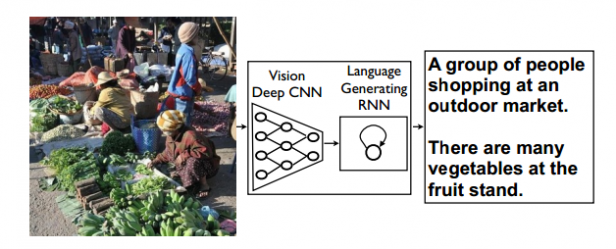
Translating one language into another has always been a difficult task. But in recent years, Google has transformed this process by developing machine translation algorithms that changing the nature of cross cultural communications through Google Translate.
Now that company is using the same machine learning technique to translate pictures into words. The result is a system that automatically generates picture captions that accurately describe the content of images. That’s something that will be useful for search engines, for automated publishing and for helping the visually impaired navigate the web and, indeed, the wider world.
The conventional approach to language translation is an iterative process that starts by translating words individually and then reordering the words and phrases to improve the translation. But in recent years, Google has worked out how to use its massive search database to translate text in an entirely different way.
The approach is essentially to count how often words appear next to, or close to, other words and then define them in an abstract vector space in relation to each other. This allows every word to be represented by a vector in this space and sentences to be represented by combinations of vectors.
Google goes on to make an important assumption. This is that specific words have the same relationship to each other regardless of the language. For example, the vector “king – man + woman = queen†should hold true in all languages.
That makes language translation a problem of vector space mathematics. Google Translate approaches it by turning a sentence into a vector and then using that vector to generate the equivalent sentence in another language.
Now Oriol Vinyals and pals at Google are using a similar approach to translate images into words. Their technique is to use a neural network to study a dataset of 100,000 images and their captions and so learn how to classify the content of images.
But instead of producing a set of words that describe the image, their algorithm produces a vector that represents the relationship between the words. This vector can then be plugged into Google’s existing translation algorithm to produce a caption in English, or indeed in any other language. In effect, Google’s machine learning approach has learnt to “translate†images into words.
To test the efficacy of this approach, they used human evaluators recruited from Amazon’s Mechanical Turk to rate captions generated automatically in this way along with those generated by other automated approaches and by humans.
The results show that the new system, which Google calls Neural Image Caption, fares well. Using a well known dataset of images called PASCAL, Neural image Capture clearly outperformed other automated approaches. “NIC yielded a BLEU score of 59, to be compared to the current state-of-the-art of 25, while human performance reaches 69,†says Vinyals and co.
That’s not bad and the approach looks set to get better as the size of the training datasets increases. “It is clear from these experiments that, as the size of the available datasets for image description increases, so will the performance of approaches like NIC,†say the Google team.
Clearly, this is yet another task for which the days of human supremacy over machines are numbered.
Ref: arxiv.org/abs/1411.4555Â Show and Tell: A Neural Image Caption Generator
Article source: http://www.technologyreview.com/view/532886/how-google-translates-pictures-into-words-using-vector-space-mathematics/
